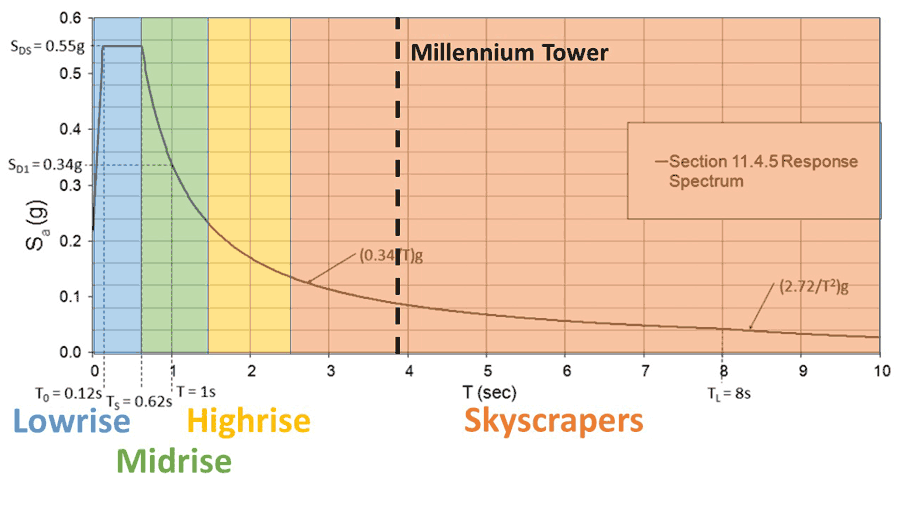
Recently, we were fortunate enough to host Dr. Lucy Jones at the AIR offices in Boston for a presentation on her work promoting resilient design in the City of Los Angeles. Dr. Jones’ talk was given during a meeting of the New England chapter of the Earthquake Engineering Research Institute (EERI), to which many at AIR belong. During her talk Dr. Jones emphasized the importance of moving toward a truly green and sustainable society by not only designing to life safety requirements but also advocating for standards that ensure that buildings are not “disposable” in the case of a significant disaster. The recent attention that high-rise buildings have received in various news reports provides an opportunity to look more deeply into tall buildings and their earthquake resilience.
Resilient Design Against Ground Shaking
Skyscrapers are striking, no doubt about it. Even the name conjures up the notion of attaining unreachable heights and “scraping the sky.” While at AIR, Dr. Paolo Bazzurro wrote an article explaining how even though local building codes allow buildings to reach a maximum height of 240 feet, developers can surpass this limit by demonstrating that the designed building can satisfy the collapse prevention (a.k.a., life safety) requirements of the code. In addition to having the building designed by a licensed engineer, the design must undergo a seismic peer review by an independent structural engineer to verify that it will satisfy the requirements of the code.
Generally, when engineers design buildings to resist earthquake ground shaking they consult a “design spectrum,” an example of which can be seen in Figure 1. The solid black line in this figure provides the relationship between T – a building’s fundamental period (the rate at which it will move back and forth in response to ground shaking)—and S(g), the spectral acceleration, or the shaking force a building is expected to experience at a given site. A building’s height is a primary driver of its fundamental period. Figure 1 shows the period ranges corresponding to different classifications of building heights.

From this relationship it can be seen that shorter buildings are generally expected to experience proportionally larger forces than taller buildings when subjected to earthquake ground shaking. However, even though tall buildings are designed to resist lower levels of inertial forces, it does not necessarily mean that they are less safe than shorter ones; rather, the expectation is for skyscrapers to experience proportionally lower forces relative to their size. Engineers design tall buildings accordingly.
Constructing Tall Buildings on Soft Soils: A Significant Issue
San Francisco poses an additional, unique challenge with regard to constructing tall buildings—the type of soil on which many of the tall buildings in the downtown area are constructed is very soft. This can result in significant problems for skyscrapers for two reasons:
- Soft soil amplifies seismic forces on taller buildings with long fundamental periods. An example of this was seen during the 1989 Loma Prieta earthquake, which struck approximately 60 miles (96 km) southeast of downtown San Francisco but still caused significant damage to the buildings downtown constructed on soft soils
- Soft soil has the potential to lose its capacity to support buildings through a process called liquefaction during which saturated soils turn to soup. This can result in the tilting of buildings, which may render them unusable or unsafe
Newer Tall Buildings Have Low Probability of Collapse
As I noted, under the current design codes engineers must verify that the building satisfies the collapse prevention requirement. This requirement states that there must be a <10% probability of collapse of the building under a Maximum Credible Earthquake (MCE). The probability of an MCE occurring is very small (2% chance in 50 years) which means the absolute probability of collapse is minuscule.
Furthermore, there are guidelines regulating the construction of tall buildings that have been developed as part of the Tall Building Initiative (TBI) for the design of skyscrapers in seismically active areas. According to Jack Moehle and Farzad Naeim, who recently spoke about tall building vulnerability at the 11th National Conference on Earthquake Engineering in Los Angeles, an implicit design objective of these guidelines is to ensure reparability of these tall and prominent structures in the event of an earthquake.
These guidelines are relatively new, however, as they have only been in practice since 2010. So, while recently designed and constructed tall buildings will satisfy the life-safety criteria and serve as examples of progress moving toward a society of non-disposable buildings, there is still a degree of uncertainty regarding how the tall buildings built before 2010 will perform in an earthquake. But Jack Moehle and Farzad Naeim stressed during their lecture that we should not let the possibility of damage to tall buildings, that have historically demonstrated a very low probability of catastrophic collapse during earthquakes, distract us from the more pressing issues of soft-story buildings and non-ductile reinforced concrete structures.
Expanding the Focus of Life Safety
Dr. Jones stressed that “life safety” should focus not only on what happens in the moment during an earthquake but also on the lasting effects that linger weeks, months, or even years after an earthquake has occurred. While it’s understandable that people would focus on the earthquake resilience of buildings themselves—as buildings become taller and increasingly mixed-use (commercial/hotel/residential), more of the community becomes reliant on just a few buildings—Dr. Jones asked us to imagine life after an earthquake. Suppose you escape from your badly damaged residence—which is what building codes are designed to allow you to do—but your home needs to be torn down, rendering you homeless for an indefinite period. Not only would there be a material financial impact associated with demolishing and replacing the damaged building, but also added impact to you and your way of life. As building codes continue to develop and evolve this kind of earthquake resilience is also certainly worth contemplating.



